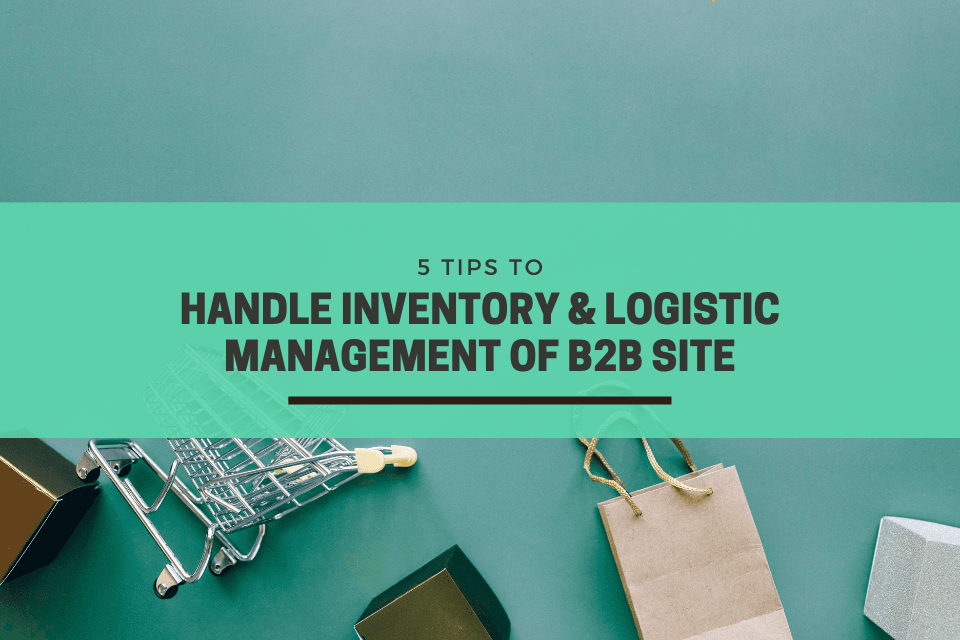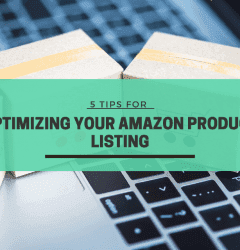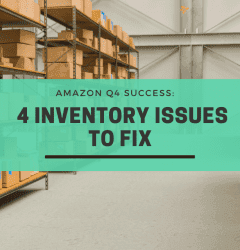This website uses cookies so that we can provide you with the best user experience possible. Cookie information is stored in your browser and performs functions such as recognising you when you return to our website and helping our team to understand which sections of the website you find most interesting and useful.
- Email: growth@growisto.com
- Phone: +1 628-280-9076
09 Sep

5 Tips to Handle Inventory & Logistic Management of B2B Site
In a rapidly changing eCommerce environment that is now focused on speed and a streamlined shopping experience, having an advanced inventory management system is a must for any B2B website. Effective inventory management is the key to keeping customers informed about the availability of products and ultimately, driving sales and maintaining a healthy long-term relationship with them.
Therefore, B2B companies need to provide not just better customer support but also inventory and logistics services in order to get rid of all the friction in their online sales channel.
To successfully satisfy the customers, B2B sellers must include vital features on their website that will help them get ahead of the game. In this blog, we are going to deep-dive into some of these key functionalities related to inventory and logistics, based on our experience of building B2B platforms:
a) Near Real-time inventory updates:
Near real-time inventory status updates should be provided on the website to provide accurate information to the customers. Inventory details provide a clear picture to the customers and contribute to streamlining its management.
Majority of B2B businesses use off-site locations to keep their stock. Moreover, if you have multiple warehouses, then showing inventory in different warehouses can also be helpful for customers planning their order and shipment timing.
From a business’s perspective, real-time inventory updates fulfill a number of operational needs. If a particular product goes out of stock suddenly, then the company becomes aware of it instantly and prompt response can be undertaken. A close analysis of popular products can also help the business gain valuable insights into what items should be kept in stock and what shouldn’t.
b) Re-ordering or re-manufacturing alerts:
When products are ordered regularly, a B2B seller can easily miss out on low stock levels between the ordering cycles. Therefore, it is advised to integrate a reorder alert functionality along with your inventory management system.
With the help of this feature, sellers will be able to get alerts to reorder the product when items cross the reorder point. This alert is to notify you in case you forget to check your item’s records.
Your inventory management system should also allow for taking into account the lead time to refill the inventory and minimum order/ production quantity if any. This will help the system to generate more accurate inventory forecasts and raise alarms at the right time. The main goal of this feature is to give sellers sufficient time to reorder and manufacture their products so that the customers don’t see out-of-stock products. Furthermore, your inventory management system can also give you the option of having your orders auto-created.
c) Next available date:
It can get frustrating for the customers to place an order just to be notified at checkout that all the products are not available. What is worse is not being able to place an order or knowing when the products will be made available for shipping!
In case B2B customers order low-in-stock or out-of-stock products, then the next available date feature will let them know when their products will be shipped. This saves the customer’s time and also reduces the chances of cart abandonment. Automatic alerts/ notifications should be sent out to the customers to let them know that the products they ordered are now available again and ready for shipping.
In fact, B2B sellers should also provide the option of partial shipments to buyers. Some buyers might want to opt for shipping their order in parts; this way they can get the available products shipped to them right now, and the rest can be shipped as and when they are restocked. However, shipping separately increases shipping costs and handling hassle, so some customers might want the entire order to be shipped together once all the products are available.
d) Different shipping options:
Considering the complexity of shipping and packaging rules based on customer needs, shipping is a key component of B2B businesses. In many cases, shipping problems can often lead to high cart abandonment rates.
If a B2B seller provides limited shipping options or charges a high price for shipping large orders to multiple locations, then customers may get frustrated. These reasons, along with many more, make the availability of custom shipping options very important for B2B eCommerce solutions.
Depending on the shipping time constraints, the package weight/volume and the ease of logistics to preferred locations, following are some of the common shipping options that B2B businesses must integrate with, in order to cater to the varying needs of their customers:
- Regular/standard shipping for small packages- For small to large boxes, regular shipping is a cost-effective delivery option. This is a standard shipping feature that includes ground delivery, 2 days shipping, and overnight shipping.
B2B sellers should specifically mention all these three options on their website. This way users get more choices and selections based on their urgency and price sensitivity. In many cases, free shipping is also offered on these regular delivery options.
- Multiple Shipping Location- In a lot of cases, B2B clients have complex shipping needs, such as delivering the products to multiple locations. Therefore, B2B companies often use drop shipping to ship items from warehouses and other manufacturers, and this strategy enables them to increase their delivery speed.
Such complex deliveries can be managed better with the help of inventory management integration on your eCommerce website. B2B companies can set particular options for free shipping, flat rate shipping, or shipping by weight. Direct onsite connections to carrier websites can directly help provide the carrier-calculated shipping rates, this is important in case of small packages as well.
- Ship-on-account- For any B2B website, ship-on-account is a vital shipping feature. Ship-on-account allows for the B2B buyers to have their own shipping vendors come and pick up the order from the B2B seller’s physical store/ warehouse location, instead of delivering it to an address.
The buyers need to provide some information to make use of this shipping option, such as the shipper’s name and the account code with the shipping vendor.
B2B sellers can also offer their buyers advanced local pickup options that enable them to visit their closest location to get the items quicker. Usually, there are no charges involved, however, sellers can add a handling fee. It is ideal to opt for this method in a custom shipping zone on the basis of local zip codes.
- LTL (Lighter Than Load)- For small freight or in case freight doesn’t require the use of an entire trailer, LTL shipping can be used for transportation. The weight range of these shipments is usually between 151 and 20,000 pounds. Therefore, B2B sellers need to provide LTL shipping options for those consumers who want to maximize their cost savings. Many carriers also charge handling fees separately for providing delivery notifications for such shipments.
In such cases, it is recommended to have an integrated inventory system that can automatically calculate the costs of LTL shipments. When shipping charges are calculated in real-time, there are fewer complaints from customers because they are already informed of all costs and the shipment status.
- Drop shipping- This shipping option allows the B2B sellers to purchase the products from a third party and then having them shipped directly to the customer. Dropshipping is a highly accessible method for the sellers to connect with customers without having the need to stockpile inventory. The seller relies on a third party, usually a wholesaler or a manufacturer, to fulfill customer orders.
- Split shipping- Split shipping option allows the customer to order multiple products at the same time but have them shipped separately. In this, the order is split in order to accommodate multiple packaging needs, changes in stock, or different shipping locations. This feature is very necessary for any B2B website, as the products are ordered in bulk and the customers might have diverse shipping needs.
- Other custom shipping options- You can also offer automated self service features and custom delivery options to customers, depending on the integration platform you are using. These include connecting to carriers onsite, selecting strategies for global shipping and automating custom address books to schedule shipments to multiple locations. Without integration, companies need multiple staff members to manage such complex shipping and multi-channel sales.
e) Custom Packaging & Labeling Options:
According to statistics, around 11 percent of buyers are satisfied with the product packaging today. However, some customers still prefer plain bubble packaging and generic packages if they save money. Therefore, to eliminate complaints from all sides, it is better to offer customers the choice to select custom options. This way they can choose if they want tailored labels and packages, or basic packaging.
All in all, the aforementioned features are vital to cater to the needs of your B2B customers and provide them with seamless inventory and logistics services. In the blink of an eye, dissatisfied customers can click away and take their business elsewhere. However, with efficient inventory management and control, the chances of this happening are much lower.
Related Post
Industries Served
United States
India








